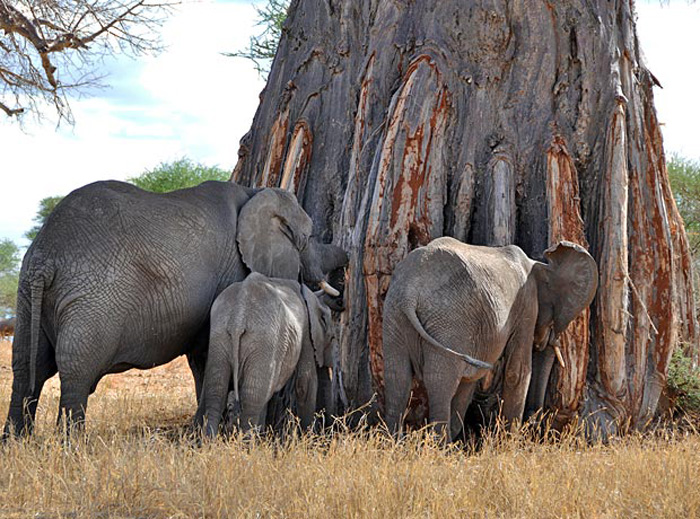Baobab and Elephant
Both are icons of Africa, easily identifiable from a distance by their distinctive shape. Both can reach considerable sizes and ideally reach very old age. They even share a similar color spectrum. It is therefore not surprising that Baobabs are sometimes referred to as “elephants” in the kingdom of plants.
The size of the baobab tree can vary, it can shrink and expand depending on its needs. In the dry season the trunk shrinks and when water is abundant, the trunk expands to support more water storage. But even though they only need a minimal amount of water they need some water – and if they do not get it over long periods they dry out and die.
A baobab’s ability to store enormous amounts of water during the rainy season usually helps them to survive dry periods. Large specimens can store up to 140,000 litres and more in specific cells in their trunk and branches. Thus, they are optimally equipped for droughts.
Tree bark that tastes like watermelon
Being so massive you would think that these trees are almost indestructible, but there is another giant in the bush that can cause great damage; the African elephant. In times of water shortage or elephant overpopulation, baobabs become very popular. Elephants instinctively know that baobabs store water and especially in the dry season when water is scarce they will look for baobab trees to quench their thirst. But elephants depend on water on a more regular basis, they need a water supply of more than 100 litres per animal per day.
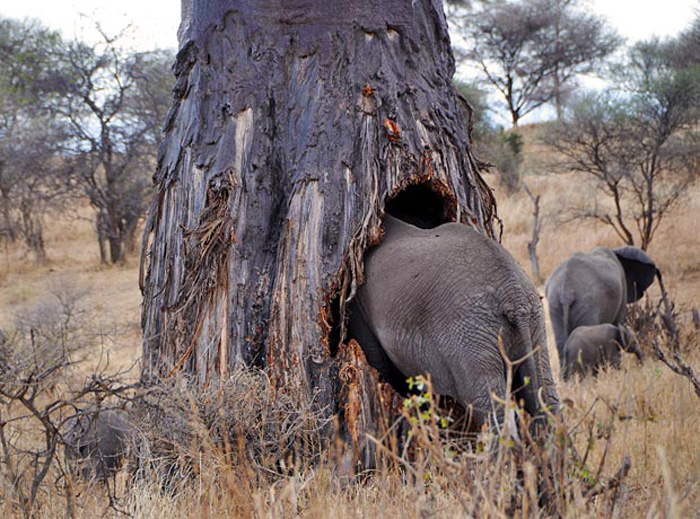
The elephants rip large pieces from the trunks of the trees or tear off entire branches to get to nutrients and stored water. And as the bark of the baobab is soft enough for an elephant to poke a hole in the bark it is easy to rip the bark off. Once the tree is stripped of its protective bark, the elephant can get to the best part – the inner part of the tree. This part is like a sponge – rather like a watermelon. Chewing on the flesh can quench an elephant’s thirst.
While the ancient plants endure elephant attacks to an amazing extent – at some point they give in to the injuries. Then, the trees collapse and dry out – usually to the benefit of the elephants who make use of them as a last snack if they are around.
Sadly, a foraging elephant might be killed by a falling over-browsed baobab, where the remaining part of recycling is completed by termites and other insects while the double tragedy soon attracted predators. After about a year nothing is left from the erstwhile giants.
Elephants Love Baobab Fruit
But there is a flip side to the coin - elephants contribute to the spreading and propagation of baobabs. Firstly, the healthy and delicious baobab fruit powder is stored in a hard shell together with many seeds. Elephants crack the fruit and swallow everything including the seeds. While they move through the digestive tract the digestive juices soften the hard seed coats.
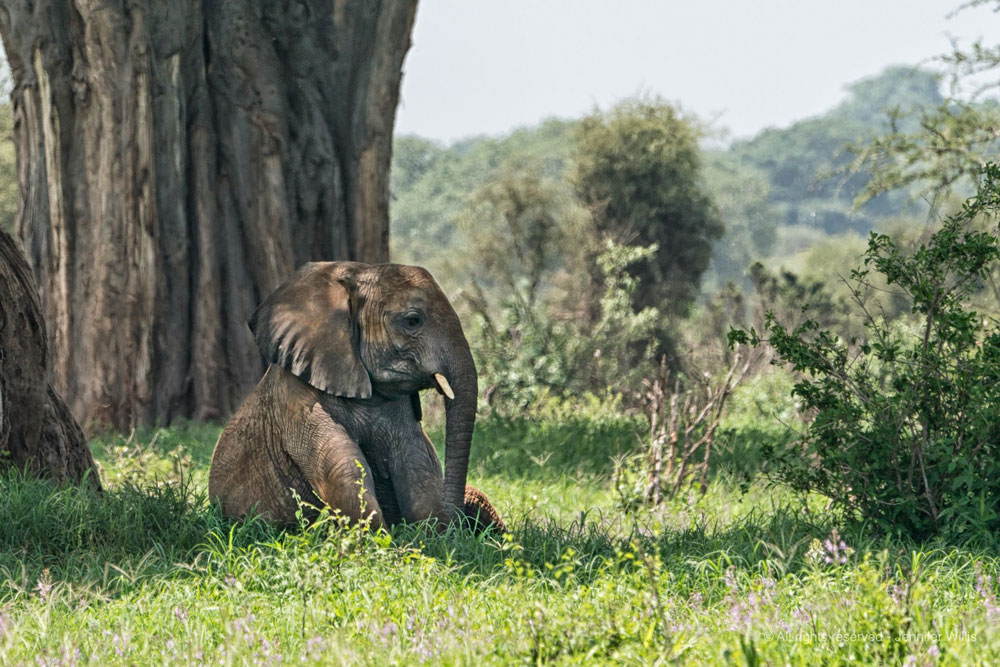
In the end, the seeds and other digestive components are disposed of in a large pile of dung: ideal conditions for germination. The mixing with digestive juices made the seed coats permeable and the remains of a former feast provide warmth, moisture and nutrients. After a perfect kick-off, all the little saplings need to be successful are regular inputs of water and a warm environment.
In addition, elephants cover long distances during their migrations. They do not necessarily drop their dung next to the parent generation of baobabs but rather transport the seeds over long distances in their stomachs. During this dissemination of baobabs other animals, such apes or antelopes are more than willing to help in reproduction.
Living with elephants seems to be difficult for baobabs – particularly during times of droughts – but life without the gentle giants does not seem to work either.
Conserving baobabs
In many parts of Africa, elephants feed off the nutritious wood pulp of the baobab trees, especially towards the end of the dry season when food is scarce. In areas of high elephant densities, some baobabs take a battering and fall. They can be protected from over-utilisation by placing large logs or sharp rocks around the base or wrapping the trunk in chicken wire.
Spekboom and elephants
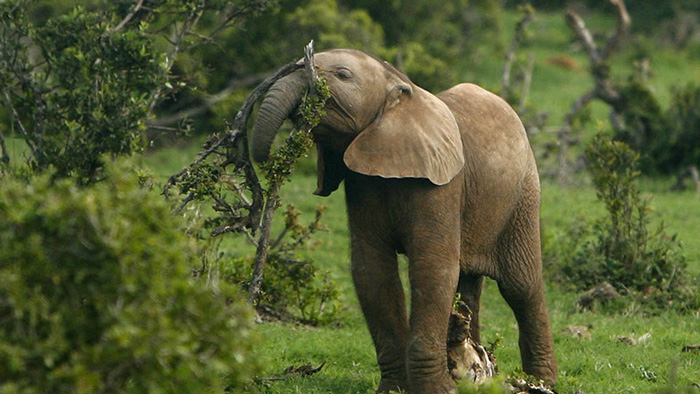
The Xhosa name for a Spekboom is iGqwanitsha. However, is better known by its descriptive name in English as Elephants Food or in Afrikaans as Spekboom, directly translating to ‘bacon tree’, which is how the name ‘porkbush’ came into being
Edible leaves
The taste of spekboom leaves are pleasant but changes throughout as the sun rises and sets. During the day leaves have an acid flavour and they become less acidic towards the evening giving it a sour flavour. The delicious greenery is heavily browsed by game and firm favourite of several wild animals, especially elephants! Filled with moisture, the tasty leaves form up to about 80% of an elephants diet and one elephant can eat up to 200 kg of Spekboom leaves a day
Demolition from the top-down
Elephants strip almost all the leaves off the Spekboom tree, but it will soon sprout new growth. The broken and down-trodden branches also develop new roots and will grow again as part of the thicket. This top-down browsing habits apparently help the plants to spread and thrive by promoting the natural umbrella-shaped canopy. Regenerating quickly Spekboom ensures a regular food supply. for the elephants because as only the canopy is browsed, the lower branches droop down to the ground promoting the natural umbrella-shaped canopy. The new shoots will develop roots and spread into new plants by vegetative new production. This drooping canopy also creates shelter, hummus and an ideal micro-climate below and around the shrub, for a variety of smaller types of vegetation to become established, binding the soil to prevent soil erosion. Spekboom regenerates quickly, ensuring regular food supply.
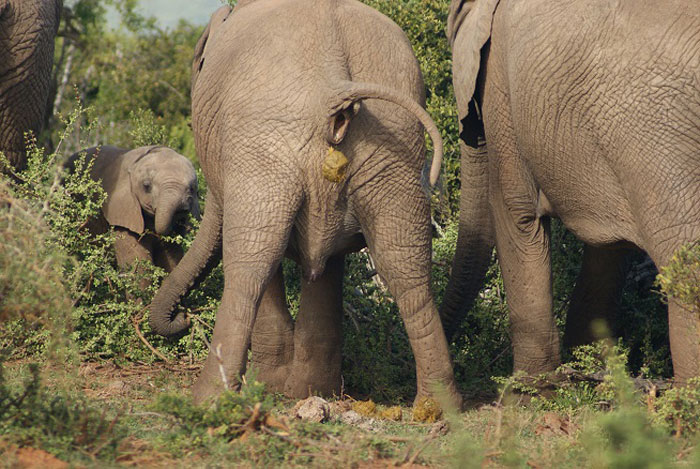
How does the Spekboom store its water?
What also makes the Spekboom so unique is that it grows in very dry semi-desert like climate. When it’s really dry, it grows like a cactus, it means it absorbs carbon dioxide at night. The plants' stomata open at night and close during the day in order to save water. This slows down evaporation and in the end, the Spekboom grows faster during the day, as it also uses the carbon dioxide it needs at night.
Forest engineers
It can form a very dense forest, too dense to even walk through and the only animals that can get through a Spekboom-forest are large herbivores like elephants, rhinos and buffalos, as they can smash their way through.

